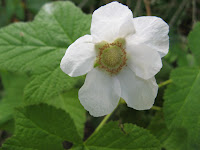So I went up to Huckleberry preserve in hopes of finding thimbleberries, a native, and supposedly delicious berry I have yet to taste. Well the first plants I found were only in flower. And while there were some berries after all further down the trail, none of them were ripe yet. It will have to wait till later.
This park always amazes me with it's variety of native plants and a wonderful, quiet beauty. Here is filtered sunlight on California grape.
I also saw a bee at work on these blackberry blossoms and another one that seems to have passed out drunk from the monkeyflower nectar. He didn't move for a good minute or more. Better for my camera.
I don't know if I'm more aware, but I swear that some plants are more common now than just a few years ago. California rose for example is scattered along the trail in quite a few spots now. Here's a rosehip just starting to form. And although most of the rose blooms were done for the year, a few more were getting ready to open.
Another reason I came to the preserve was to look for California hazelnuts (Corylus cornuta var californica). Also edible, but not quite ripe. A very strange, but beautiful housing for the future nuts. And the buds just awakening.
And I wanted to see if there were any ribes berries to sample. The ribes species that grow in the park I don't think are very tasty, but I'm still curious to try some. They weren't ripe either.
It seems like our wet and late winter pushed some things back from their usual cycle. Luckily I didn't mind just having a pleasant walk through the woods.
Saturday, June 26, 2010
Wednesday, June 23, 2010
World Cup Grass
So in honor of the US qualifying this morning for the second round of the World Cup (my current obsession which is keeping me from blogging), here's a quick post on the controversy of the grass used for this year's World Cup in South Africa. (Though probably not as controversial as one of the referee's calls.) Evidently the original plan was to use kikuyu grass, which is native to Africa, overseeded with rye grass. Kikuyu is the norm on fields, or pitches, as some of our English-speaking cousins call them, in South Africa. Rye grass the norm in Europe. Evidently the kikuyu is tough and has a bit of bounce to it. But FIFA, the world-governing organization for soccer decided it wasn't green enough for television.
My favorite line: ''The ryegrass requires more water, fertiliser and maintenance than kikuyu." But as we all know people must have their visually perfect lawn. The rye grass fields won't last past the winter and will be replaced with kikuyu after the show.
My favorite line: ''The ryegrass requires more water, fertiliser and maintenance than kikuyu." But as we all know people must have their visually perfect lawn. The rye grass fields won't last past the winter and will be replaced with kikuyu after the show.
Sunday, June 20, 2010
San Pablo Reservoir
So about a week ago, I went on a short hike with a friend of mine near San Pablo Reservoir in the hills between Orinda and El Sobrante (East of Berkeley). It was a nice sunny day and I was surprised by some of the plants I found, since I assumed it would be overrun by exotics.
Indian paintbrush. Always one of my favorites.
Lots and lots of monkeyflower. Such a beautiful flower, too bad it's not always a garden-worthy plant.
I think this is pearlyeverlasting, something I've never seen, but when I saw it I figured this must be it. A very descriptive common name. [edit: Thanks to Katie at Nature ID, it looks like this is probably California cudweed - pseudognaphalium californicum.]
And I think at least some of this is purple needlegrass.
And anyone know what this beautiful little flower is? [edit: A second thanks to Katie at Nature ID for this one, Platystemon californicum, or California cream cup. A lovely little flower.]
Indian paintbrush. Always one of my favorites.
Lots and lots of monkeyflower. Such a beautiful flower, too bad it's not always a garden-worthy plant.
I think this is pearlyeverlasting, something I've never seen, but when I saw it I figured this must be it. A very descriptive common name. [edit: Thanks to Katie at Nature ID, it looks like this is probably California cudweed - pseudognaphalium californicum.]
And I think at least some of this is purple needlegrass.
And anyone know what this beautiful little flower is? [edit: A second thanks to Katie at Nature ID for this one, Platystemon californicum, or California cream cup. A lovely little flower.]
Labels:
hiking
Thursday, June 3, 2010
More about bees
So I'm a little behind in posting. What can I say, it's summer. But here is a really interesting, and short, article my cousin (the bee expert) shared. It's about a bee species found in Turkey and Iran at least. Enjoy.
Subscribe to:
Comments (Atom)


















